35+ Purine-Rich Foods: What to Avoid for Gout Prevention
Ever heard of purines? These little compounds are hiding in some of your favorite foods, and they can pack a punch when it comes to your health.
Whether you’re managing gout or just trying to eat smarter, understanding purine-rich foods is key.
Buckle up as we dive into the world of purines – from seafood to veggies, we’ve got the lowdown on what’s what in the purine game.

Seafood Sensations
Anchovies
These tiny fish pack a big flavor punch, but they’re also swimming in purines.
A staple in Caesar salads and pizza toppings, anchovies are a concentrated source of umami goodness.
But watch out – their small size means you might eat more than you realize, ramping up your purine intake.
| Nutrient | Amount per 100g |
|---|---|
| Calories | 131 |
| Protein | 20.4g |
| Fat | 4.8g |
| Purines | 239mg |
Sardines
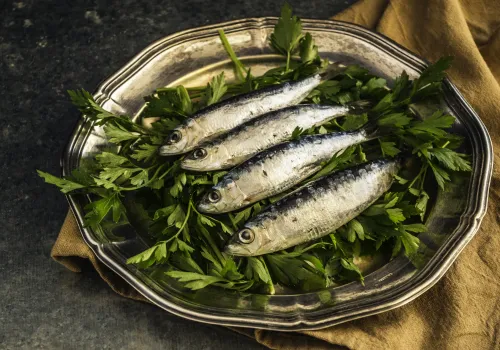
Sardines are the ultimate convenience food – pop open a can, and you’ve got a nutrient-dense meal ready to go.
These little fish are loaded with omega-3s and calcium, thanks to their edible bones.
But they’re also purine heavyweights, so moderation is key if you’re watching your intake.
| Nutrient | Amount per 100g |
|---|---|
| Calories | 208 |
| Protein | 24.6g |
| Fat | 11.5g |
| Purines | 345mg |
Mackerel
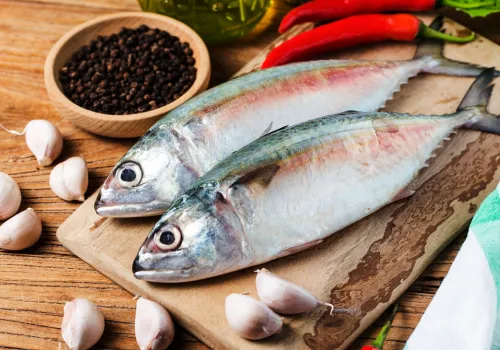
Mackerel is a fatty fish favorite, prized for its rich flavor and impressive omega-3 content. It’s a go-to for heart health and brain function.
But like its seafood siblings, mackerel is high in purines.
Enjoy it occasionally, but don’t make it an everyday indulgence if you’re purine-conscious.
| Nutrient | Amount per 100g |
|---|---|
| Calories | 205 |
| Protein | 18.6g |
| Fat | 13.9g |
| Purines | 281mg |
Tuna
Tuna, whether fresh or canned, is a protein powerhouse that’s a staple in many American diets.
It’s versatile, convenient, and packed with nutrients like vitamin D and selenium.
But heads up – tuna’s also high in purines. If you’re a tuna sandwich fanatic, you might want to mix up your lunch routine.
| Nutrient | Amount per 100g |
|---|---|
| Calories | 144 |
| Protein | 23.3g |
| Fat | 4.9g |
| Purines | 257mg |
Trout
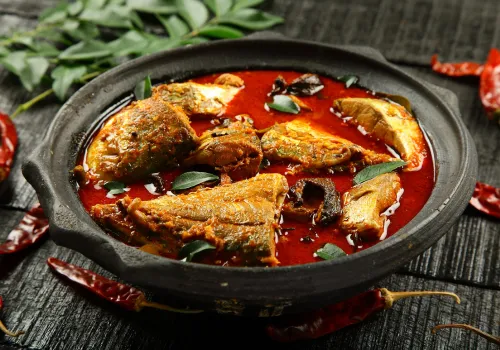
Trout is the darling of freshwater fishing and a favorite on many restaurant menus.
It’s got a delicate flavor and is rich in B vitamins and potassium.
But like its seafood cousins, trout is high in purines.
Enjoy it as an occasional treat rather than a daily dish if you’re watching your purine intake.
| Nutrient | Amount per 100g |
|---|---|
| Calories | 141 |
| Protein | 19.9g |
| Fat | 6.2g |
| Purines | 297mg |
Haddock
Haddock is a mild-flavored white fish that’s popular in fish and chips. It’s lean, low in calories, and a good source of protein and minerals.
While lower in purines than some other seafood options, haddock still contains moderate levels.
It can be a good choice for those looking to reduce purine intake while still enjoying fish.
| Nutrient | Amount per 100g |
|---|---|
| Calories | 90 |
| Protein | 20.6g |
| Fat | 0.9g |
| Purines | 110-140mg |
Herring
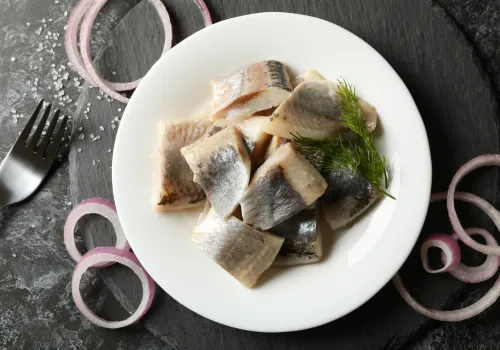
Herring is a small, oily fish that’s often pickled, smoked, or eaten fresh. It’s rich in omega-3 fatty acids and vitamin D, making it a nutritional powerhouse.
However, herring is also high in purines.
If you’re prone to gout or kidney stones, you might want to limit your intake of this flavorful fish.
| Nutrient | Amount per 100g |
|---|---|
| Calories | 158 |
| Protein | 18g |
| Fat | 9g |
| Purines | 210-260mg |
Mussels
Mussels are a popular shellfish known for their sweet, tender meat.
They’re an excellent source of vitamin B12, iron, and selenium.
But be aware – mussels are high in purines. If you’re on a low-purine diet, you might want to save these for special occasions.
| Nutrient | Amount per 100g |
|---|---|
| Calories | 86 |
| Protein | 11.9g |
| Fat | 2.2g |
| Purines | 270-320mg |
Scallops

Scallops are prized for their delicate, sweet flavor and tender texture.
They’re low in calories and fat, but high in protein and various nutrients.
However, scallops are also high in purines.
If you’re watching your purine intake, you might want to enjoy these sea treasures sparingly.
| Nutrient | Amount per 100g |
|---|---|
| Calories | 88 |
| Protein | 16.8g |
| Fat | 0.8g |
| Purines | 240-290mg |
Codfish
Cod is a popular white fish known for its mild flavor and flaky texture.
It’s low in fat and calories, making it a favorite among health-conscious eaters.
While cod contains purines, it’s generally lower than many other types of seafood.
It can be a good option for those looking to reduce their purine intake while still enjoying fish.
| Nutrient | Amount per 100g |
|---|---|
| Calories | 82 |
| Protein | 17.8g |
| Fat | 0.7g |
| Purines | 90-130mg |
Meat and Poultry Picks
Beef
Beef is as American as apple pie, from juicy burgers to sizzling steaks. It’s a rich source of iron, B vitamins, and high-quality protein.
But it’s also a significant source of purines, especially organ meats.
Opt for leaner cuts and smaller portions if you’re keeping an eye on your purine consumption.
| Nutrient | Amount per 100g |
|---|---|
| Calories | 250 |
| Protein | 26g |
| Fat | 17g |
| Purines | 120-150mg |
Lamb
Lamb is a flavorful red meat popular in many cuisines. It’s rich in protein, iron, and B vitamins, particularly vitamin B12.
However, like other red meats, lamb is high in purines.
If you’re watching your purine intake, you might want to enjoy lamb as an occasional treat rather than a regular part of your diet.
| Nutrient | Amount per 100g |
|---|---|
| Calories | 294 |
| Protein | 25g |
| Fat | 21g |
| Purines | 140-190mg |
Veal
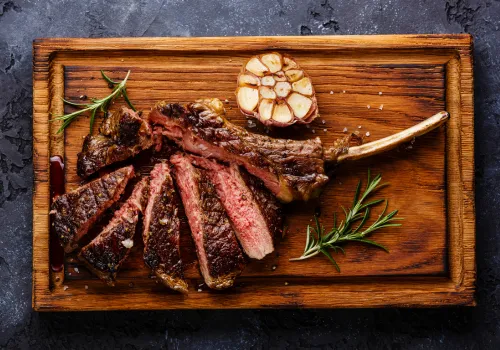
Veal, the meat from young cattle, is known for its tender texture and mild flavor.
It’s a good source of protein, zinc, and B vitamins.
While generally lower in fat than beef, veal still contains significant amounts of purines.
Those on a low-purine diet should consume it in moderation.
| Nutrient | Amount per 100g |
|---|---|
| Calories | 172 |
| Protein | 24g |
| Fat | 8g |
| Purines | 140-180mg |
Turkey
Turkey isn’t just for Thanksgiving anymore.
This lean protein is a popular choice for sandwiches, ground meat dishes, and as a healthier alternative to beef.
While lower in purines than red meat, turkey still contains a moderate amount.
Dark meat and the skin have higher purine levels, so stick to white meat if you’re being cautious.
| Nutrient | Amount per 100g |
|---|---|
| Calories | 189 |
| Protein | 29g |
| Fat | 7g |
| Purines | 150-175mg |
Goose
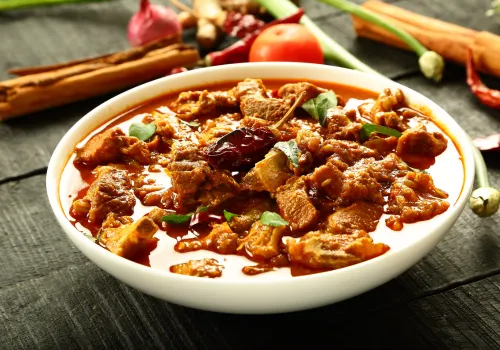
Goose is a rich, flavorful poultry often enjoyed during holiday seasons. It’s high in protein and iron, but also higher in fat compared to other poultry.
Goose meat contains moderate to high levels of purines.
If you’re watching your purine intake, it’s best to enjoy goose in small portions and less frequently.
| Nutrient | Amount per 100g |
|---|---|
| Calories | 305 |
| Protein | 22g |
| Fat | 22g |
| Purines | 160-200mg |
Duck
Duck is known for its rich, dark meat and crispy skin. It’s a good source of protein, iron, and B vitamins.
However, duck is also high in fat and contains moderate to high levels of purines.
Those on a low-purine diet should consume duck sparingly.
| Nutrient | Amount per 100g |
|---|---|
| Calories | 337 |
| Protein | 19g |
| Fat | 28g |
| Purines | 170-210mg |
Chicken
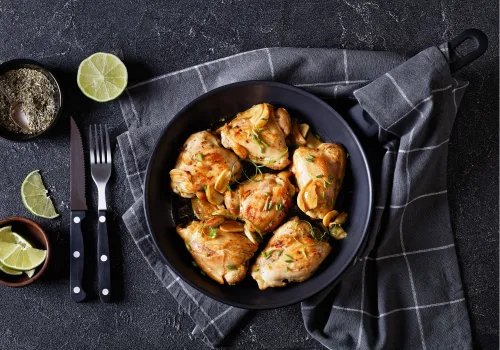
Chicken is the go-to protein for many health-conscious Americans.
It’s versatile, relatively inexpensive, and lower in fat than many other meats.
When it comes to purines, chicken is moderate – better than red meat, but not as low as plant-based proteins. Removing the skin can help reduce the purine content.
| Nutrient | Amount per 100g |
|---|---|
| Calories | 165 |
| Protein | 31g |
| Fat | 3.6g |
| Purines | 140-175mg |
Organ Meat Matters
Liver
Liver might not be everyone’s cup of tea, but it’s a nutritional powerhouse.
Packed with iron, vitamin A, and B vitamins, liver is a superfood in its own right.
However, it’s also one of the highest purine foods out there.
If you’re watching your purine intake, liver should be an occasional indulgence at most.
| Nutrient | Amount per 100g |
|---|---|
| Calories | 135 |
| Protein | 20.4g |
| Fat | 3.6g |
| Purines | 460-1000mg |
Kidney
Kidney, while not as popular as liver, is another organ meat that packs a nutritional punch. It’s rich in iron, zinc, and B vitamins.
Like liver, kidney is very high in purines.
It’s best avoided or eaten in very small amounts if you’re on a low-purine diet.
| Nutrient | Amount per 100g |
|---|---|
| Calories | 131 |
| Protein | 22.6g |
| Fat | 3.1g |
| Purines | 700-900mg |
Sweetbreads
Sweetbreads, which are actually the thymus gland or pancreas of young animals, are considered a delicacy in many cuisines. They’re rich in protein and vitamins.
However, like other organ meats, sweetbreads are very high in purines. Those watching their purine intake should avoid or strictly limit consumption.
| Nutrient | Amount per 100g |
|---|---|
| Calories | 321 |
| Protein | 17g |
| Fat | 27g |
| Purines | 750-1000mg |
Heart
Heart meat is a nutrient-dense organ meat, rich in iron, zinc, and B vitamins. It’s leaner than many other cuts of meat.
However, like other organ meats, heart is high in purines. Those on a low-purine diet should consume it sparingly, if at all.
| Nutrient | Amount per 100g |
|---|---|
| Calories | 112 |
| Protein | 17g |
| Fat | 3.9g |
| Purines | 350-450mg |
Brain
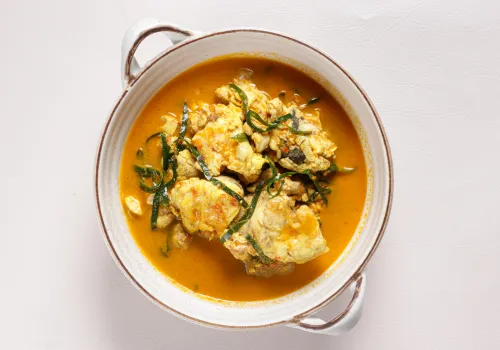
Brain, while not commonly eaten in many Western cultures, is considered a delicacy in some cuisines.
It’s rich in omega-3 fatty acids and certain vitamins.
However, brain is very high in cholesterol and purines.
It’s generally recommended to avoid brain meat if you’re on a low-purine diet.
| Nutrient | Amount per 100g |
|---|---|
| Calories | 143 |
| Protein | 10g |
| Fat | 11g |
| Purines | 300-400mg |
Veggie Ventures
Asparagus
Asparagus is a spring favorite that brings a touch of elegance to any plate. It’s low in calories but high in folate, fiber, and antioxidants.
While most veggies are low in purines, asparagus is an exception.
It’s still lower than most meats, but higher than other vegetables. Enjoy in moderation if you’re watching your purine intake.
| Nutrient | Amount per 100g |
|---|---|
| Calories | 20 |
| Protein | 2.2g |
| Fiber | 2.1g |
| Purines | 50-100mg |
Cauliflower
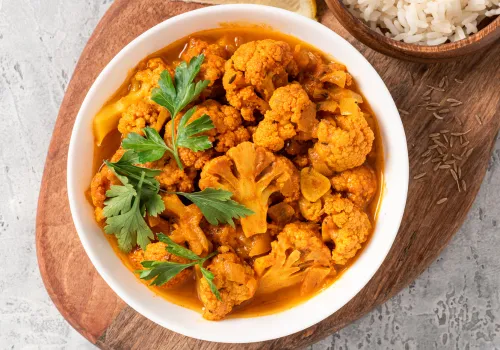
Cauliflower has become a low-carb darling in recent years, subbing in for everything from rice to pizza crust.
It’s packed with vitamin C and other antioxidants.
While it does contain purines, the levels are much lower than in animal products.
Most people don’t need to worry about cauliflower’s purine content unless they’re extremely sensitive.
| Nutrient | Amount per 100g |
|---|---|
| Calories | 25 |
| Protein | 1.9g |
| Fiber | 2g |
| Purines | 50-100mg |
Spinach
Popeye was onto something with spinach. This leafy green superhero is loaded with iron, calcium, and a host of vitamins and minerals.
While it does have more purines than many other vegetables, it’s still considered a healthy choice for most people.
The benefits of spinach usually outweigh purine concerns for those without severe sensitivities.
| Nutrient | Amount per 100g |
|---|---|
| Calories | 23 |
| Protein | 2.9g |
| Fiber | 2.2g |
| Purines | 50-100mg |
Mushrooms
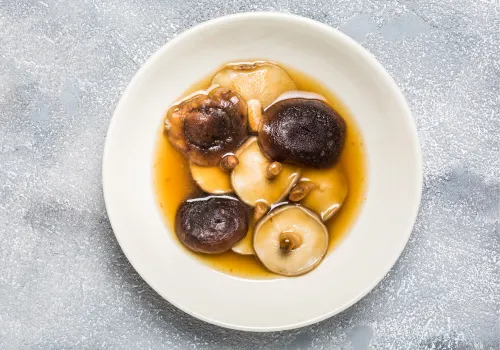
Mushrooms are flavor-packed fungi that add depth to many dishes. They’re low in calories and rich in B vitamins and selenium.
While mushrooms do contain purines, the levels are generally lower than in meats.
Most people can enjoy mushrooms as part of a balanced diet, even if they’re watching their purine intake.
| Nutrient | Amount per 100g |
|---|---|
| Calories | 22 |
| Protein | 3.1g |
| Fiber | 1g |
| Purines | 50-100mg |
Peas
Peas are sweet, starchy vegetables that are popular both fresh and frozen. They’re a good source of protein, fiber, and various vitamins and minerals.
Peas contain moderate amounts of purines, higher than many other vegetables but still lower than most meats.
They can be included in a low-purine diet in moderation.
| Nutrient | Amount per 100g |
|---|---|
| Calories | 81 |
| Protein | 5.4g |
| Fiber | 5.1g |
| Purines | 80-130mg |
Legume Lowdown
Lentils
Lentils are a budget-friendly protein that’s a staple in cuisines around the world.
They’re high in fiber, folate, and iron, making them a nutritional powerhouse.
While lentils do contain purines, they’re generally considered a healthier choice than animal proteins.
Their fiber content may help offset some of the purine effects.
| Nutrient | Amount per 100g (cooked) |
|---|---|
| Calories | 116 |
| Protein | 9g |
| Fiber | 7.9g |
| Purines | 100-150mg |
Chickpeas
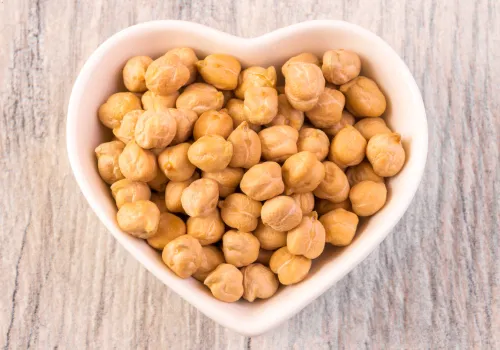
Also known as garbanzo beans, chickpeas are the star of hummus and a versatile legume that’s gained popularity in recent years.
They’re rich in protein, fiber, and minerals.
Like other legumes, chickpeas contain moderate amounts of purines.
However, their overall health benefits make them a good choice for most people, even those watching their purine intake.
| Nutrient | Amount per 100g (cooked) |
|---|---|
| Calories | 164 |
| Protein | 8.9g |
| Fiber | 7.6g |
| Purines | 100-150mg |
Beans (various types)
Beans, whether they’re black, kidney, pinto, or navy, are nutritional powerhouses.
They’re high in protein, fiber, and various vitamins and minerals.
While beans do contain moderate amounts of purines, they’re still considered a healthy food choice for most people.
The fiber in beans may help mitigate some of the effects of purines.
| Nutrient | Amount per 100g (cooked) |
|---|---|
| Calories | 127 (average) |
| Protein | 8.7g (average) |
| Fiber | 7.4g (average) |
| Purines | 100-150mg |
Yeast and Yeast Extracts
Brewer’s Yeast
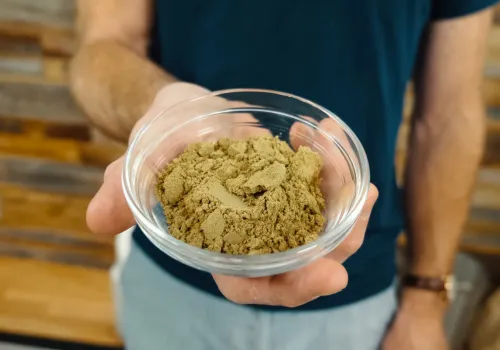
Brewer’s yeast isn’t just for brewing beer – it’s also a popular nutritional supplement.
It’s rich in B vitamins and minerals like chromium and selenium.
However, it’s also high in purines.
If you’re using brewer’s yeast as a supplement, be aware of its purine content, especially if you have gout or kidney issues.
| Nutrient | Amount per 2 tablespoons |
|---|---|
| Calories | 60 |
| Protein | 8g |
| Fiber | 4g |
| Purines | 300-1000mg |
Nutritional Yeast
Nutritional yeast, or “nooch” to its fans, has become a vegan favorite for its cheesy flavor and nutritional profile. It’s fortified with B12 and other B vitamins.
While lower in purines than brewer’s yeast, it still contains a moderate amount.
Most people can enjoy it in moderation, but those on strict low-purine diets may need to limit their intake.
| Nutrient | Amount per 2 tablespoons |
|---|---|
| Calories | 60 |
| Protein | 8g |
| Fiber | 4g |
| Purines | 150-250mg |
Marmite
Marmite, a British yeast extract spread, is known for its strong, savory flavor. It’s rich in B vitamins and often used in small amounts as a flavoring.
Like other yeast products, Marmite is high in purines.
Those on a low-purine diet should use it sparingly or avoid it altogether.
| Nutrient | Amount per 100g |
|---|---|
| Calories | 169 |
| Protein | 39g |
| Fat | 0.1g |
| Purines | 300-450mg |
Vegemite

Vegemite, an Australian yeast extract spread, is similar to Marmite but with its own unique flavor profile.
It’s also rich in B vitamins and used as a savory spread.
Like Marmite, Vegemite is high in purines due to its yeast content.
Those watching their purine intake should use it in moderation or find alternatives.
| Nutrient | Amount per 100g |
|---|---|
| Calories | 180 |
| Protein | 25g |
| Fat | 0.9g |
| Purines | 300-450mg |
Other Considerations
Gravies
Gravies are a comfort food staple, adding richness to everything from mashed potatoes to biscuits.
They’re often made from meat drippings, which concentrates the purine content.
If you’re watching your purine intake, gravies are best enjoyed sparingly.
Consider vegetable-based alternatives or lighter sauces as substitutes.
| Nutrient | Amount per 100g |
|---|---|
| Calories | Varies |
| Protein | Varies |
| Fat | Varies |
| Purines | 200-300mg |
Broths made from meat
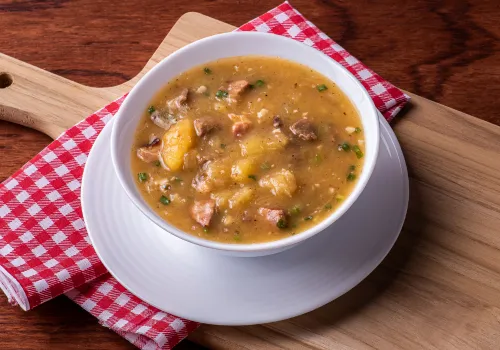
Meat-based broths, whether chicken, beef, or other varieties, are the foundation of many soups and sauces.
They’re flavorful and can be rich in minerals.
However, the cooking process concentrates the purines from the meat into the broth.
Those on a low-purine diet might want to opt for vegetable-based broths instead.
| Nutrient | Amount per 100g |
|---|---|
| Calories | 10-30 |
| Protein | 1-5g |
| Fat | 0-2g |
| Purines | 150-250mg |
Final Thoughts
Navigating the world of purine-rich foods doesn’t have to be a headache.
While some foods pack a purine punch, remember that balance is key.
For most folks, a varied diet with moderation in high-purine foods is the way to go.
If you’re dealing with gout or kidney issues, chat with your doc for personalized advice.
Armed with this knowledge, you’re all set to make informed choices that keep your taste buds happy and your body healthy!
